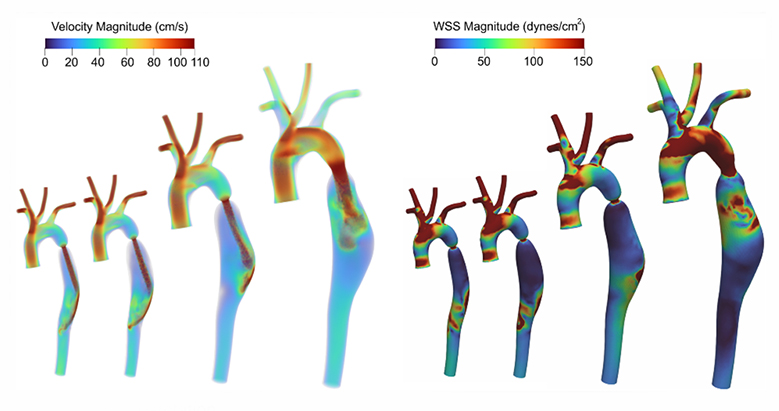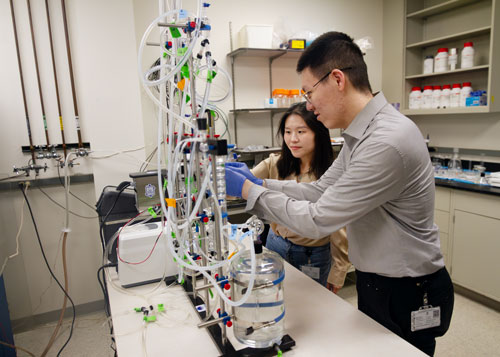Azarnoosh MCW Wins Scientific Image Award
About FSI Simulations for CoA | About Dr. Azarnoosh
Dr. Jamasp Azarnoosh, BME Postdoctoral Researcher working under Dr. John LaDisa—Professor of Physiology and Director of the Computational Engineering and Visualization Program at the Medical College of Wisconsin—was recently awarded second place for Postdoc Entrants in MCW's Graduate Student and Postdoc Best Scientific Image contest. The contest is overseen by MCW's Postdoctoral Advisory Committee and solicits images created during the course of biomedical research. Dr. Azarnoosh was recognized for his image elucidating instantaneous velocity and wall shear stress in Coarctation of the Aorta using Fluid-Structure Interaction simulation.

About FSI Simulations for Coarctation of the Aorta
Coarctation of the Aorta (CoA) is one of the most common congenital heart defects, which is present at birth as a narrowing in the aorta. The main goal of this study is to quantify temporal alterations in mechanical stimuli and changes in arterial properties for the range of CoA severities and durations seen clinically using computational simulation, i.e., fluid-structure interaction (FSI). FSI is a great tool to simulate blood flow in the aorta and enables a non-invasive assessment of in vivo hemodynamic parameters, including blood velocity and wall shear stress (WSS). The figures show instantaneous velocity and WSS magnitude at peak systolic in the aorta of a rabbit model considering four age stages. This rabbit model represents the most severe case of CoA with the treated condition in which the narrowing enlarges over time. This study links pathologic remodeling to mechanical stimuli using empirical testing and FSI simulations.
more about imaging at MU-MCW BME
About Dr. Azarnoosh
 Dr. Azarnoosh is currently a postdoctoral research fellow working under the mentorship of Dr. John LaDisa in the Joint Department of Biomedical Engineering at Marquette University and the Medical College of Wisconsin. His research focuses on temporal evolution coarctation of the aorta with the use of Fluid-Structure Interaction (FSI). He obtained his Ph.D. in Mechanical Engineering at the University of Texas at Dallas under the supervision of Dr. Fatemeh Hassanipour with dissertation focused on understanding of the biomechanics of breastfeeding. His current research interests include biomechanics, biofluids, and medical devices.
Dr. Azarnoosh is currently a postdoctoral research fellow working under the mentorship of Dr. John LaDisa in the Joint Department of Biomedical Engineering at Marquette University and the Medical College of Wisconsin. His research focuses on temporal evolution coarctation of the aorta with the use of Fluid-Structure Interaction (FSI). He obtained his Ph.D. in Mechanical Engineering at the University of Texas at Dallas under the supervision of Dr. Fatemeh Hassanipour with dissertation focused on understanding of the biomechanics of breastfeeding. His current research interests include biomechanics, biofluids, and medical devices.
View more MU-MCW BME News


 Dr. Azarnoosh is currently a postdoctoral research fellow working under the mentorship of Dr. John LaDisa in the Joint Department of Biomedical Engineering at Marquette University and the Medical College of Wisconsin. His research focuses on temporal evolution coarctation of the aorta with the use of Fluid-Structure Interaction (FSI). He obtained his Ph.D. in Mechanical Engineering at the University of Texas at Dallas under the supervision of Dr. Fatemeh Hassanipour with dissertation focused on understanding of the biomechanics of breastfeeding. His current research interests include biomechanics, biofluids, and medical devices.
Dr. Azarnoosh is currently a postdoctoral research fellow working under the mentorship of Dr. John LaDisa in the Joint Department of Biomedical Engineering at Marquette University and the Medical College of Wisconsin. His research focuses on temporal evolution coarctation of the aorta with the use of Fluid-Structure Interaction (FSI). He obtained his Ph.D. in Mechanical Engineering at the University of Texas at Dallas under the supervision of Dr. Fatemeh Hassanipour with dissertation focused on understanding of the biomechanics of breastfeeding. His current research interests include biomechanics, biofluids, and medical devices.
